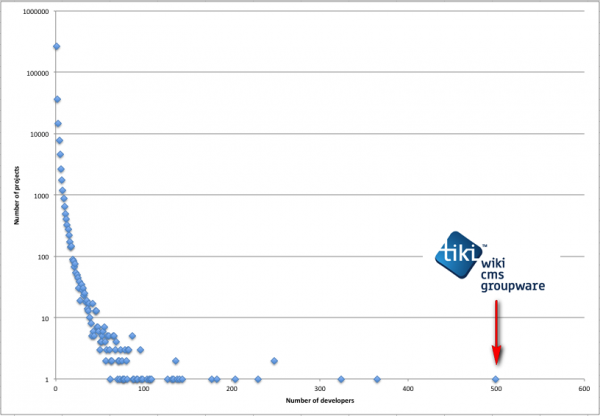Last week’s interview about the Tiki Wiki project got me looking closer at the data, and I wanted to share a few of my findings with you.
First of all, here’s that graph again:
That shows the distribution of projects vs how many developers are on a project. 268,554 projects have only one developer. Whether that represents projects that simply don’t have a very wide appeal, or if it is project admins holding on to the reins a little too tightly, that represents a lot of code that will be orphaned if just one person loses interest, has a change in their available free time, or, as is inevitable some day, dies.
At the other end of the spectrum, there are 21 projects that have more than 100 committers. Some of these are names you may have heard before, while others may come as a surprise.
| Project | Developer Count |
| Firebird | 104 |
| Gene Ontology | 106 |
| CARE2X php Integ Hospital Info System | 107 |
| IT Process Models Repository | 109 |
| Boost C++ Libraries | 127 |
| Inkscape | 133 |
| tagua | 134 |
| eStudy | 136 |
| Generic Model Organism Database Project | 136 |
| Mediaportal Plugins | 140 |
| ADempiere ERP Business Suite | 141 |
| VeniVidiWiki | 144 |
| jEdit | 177 |
| XOOPS Web Application Platform | 183 |
| GamesCrafters | 204 |
| Apertium: machine translation toolbox | 230 |
| The Plone Collective | 248 |
| Moodle | 248 |
| TinyOS | 324 |
| work-in-progress pkgsrc packages | 365 |
| Tiki Wiki CMS Groupware | 500 |
But what these numbers mean is far from obvious. As was mentioned in the Tiki Wiki interview, although there are 500 committers, only 260 of them have actually committed anything.
And that VeniVidiWiki project looks decidedly fishy, with the project registered on 2004-05-24, the latest activity on 2004-06-25, but with 144 committers. What does that mean? It turns out that it was part of a University course, where all of the students in the course had to take part in an Open Source project, so they started one from scratch. When the course was over, the project was over, too.
I’m always a little skeptical about the use of numbers to prove much of anything about an Open Source project – who’s to say that 1000 commits are in any way better than 100 commits? The proof is in the code, the longevity of the project, the quality of the end product.
But the hypothesis that a large committer base leads to a sustainable project seems to work out in this particular statistical sample, with all but three of the project showing some activity in the last couple of months.
This is all, of course, very unscientific, and I hope, over the coming months, to have conversations with various of these projects, and investigate further what seems to work when it comes to deciding who gets commit rights and who doesn’t. But I thought you’d like to see some of the data I’m working with.
